Carcharhinus limbatus

This medium sized, stocky shark is dark grey to brown on top transitioning to white underneath. It has characteristically marked black-tipped fins. Blacktip sharks prefer to hunt small schooling fishes, taking out prey as they move quickly through the school, often breaching the water at the surface. They are generally timid, but because they forage in shallower waters (less than 100 ft), are frequently encountered by humans. This has resulted in a few bites that are cases of mistaken identity where the shark mistakes a swimmer, or a surfer’s arm or leg for a prey item (Compagno et al. 2005).
Order – Carcharhiniformes
Family – Carcharhinidae
Genus – Carcharhinus
Species – limbatus
Common Names
The blacktip shark gets its name from its distinctive black markings on the tips of its fins. It is also known as blackfin (Guam, Micronesia, Trinidad and Tobago), black-tipped (Papua New Guinea), small blacktip (Cuba, Leeward Islands), and spot-fin ground shark (UK).
Importance to Humans
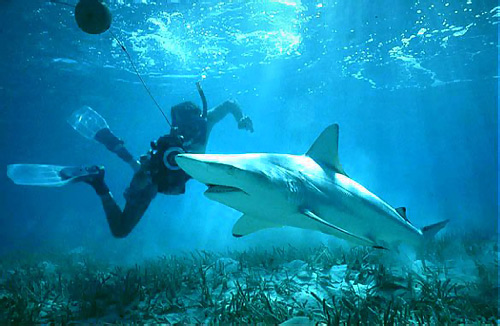
The blacktip shark is targeted in a number of commercial fisheries, including the longline fishery off the southeast coast of the U.S. where it is the second most important species to the fishery behind the Sandbar Shark. Blacktip sharks compromised about 9% of the shark catch in the Southeastern U.S. from 1994-2005 (Morgan and Burgess 2005). It is also regularly captured in fixed bottom nets and in shrimp trawls. The meat is used for fish meal or sold in local markets for human consumption. The fins are sold to Asian markets and the hides are used for leather (Burgess and Branstetter 2009).
Blacktip sharks are sometimes caught by sport fishermen off Florida, the Caribbean islands, and South Africa. They are reported to give a good fight, often leaping out of the water. According to the International Game Fish Association (IGFA) the record size blacktip shark was caught in the Bahamas on rod and reel and weighed 270 lbs (122 kg).
Danger to Humans
Records from The International Shark Attack File (ISAF) show that blacktip sharks have historically been responsible for 29 unprovoked attacks on humans around the world. Attacks were reported in the United States (Florida, South Carolina, North Carolina, Virginia, and Alabama), the Caribbean (Bahamas and British Virgin Islands), and South Africa. Only one of these was fatal. Most incidents result in relatively minor wounds. Blacktip sharks are responsible for roughly 20% of the attacks that occur in Florida waters, often striking surfers.
View shark attacks by species on a world mapConservation
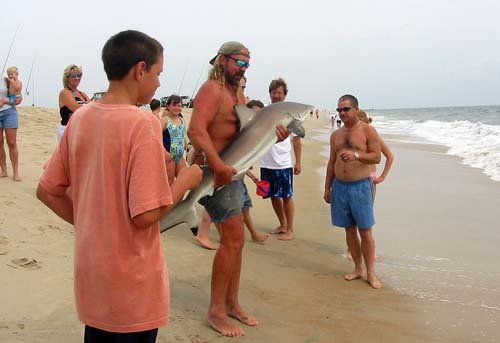
IUCN Red List Status: Near Threatened
The blacktip shark is currently managed by the National Marine Fisheries Service as a large coastal species in the Atlantic shark fishery. U.S. Catch rates have fluctuated over recent years, but reached a peak in commercial landings in 2000 in the U.S. southeast Atlantic shark fishery. The majority of the catch is comprised of adults above the minimum reproductive size, indicating that this species is currently being managed in a sustainable fashion.
> Check the status of the blacktip shark at the IUCN website.
The IUCN is a global union of states, governmental agencies, and non-governmental organizations in a partnership that assesses the conservation status of species.
Geographical Distribution
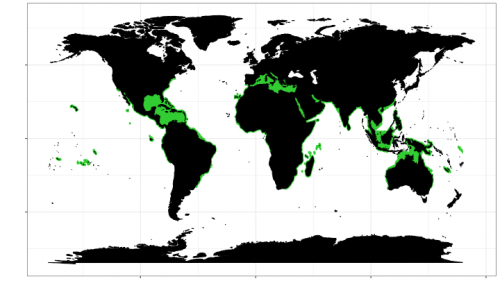
Blacktip sharks are cosmopolitan in tropical to subtropical coastal, shelf, and island waters. In the Atlantic during their seasonal migration they range from Massachusetts to Brazil, but their center of abundance is in the Gulf of Mexico and Caribbean Sea. They occur throughout the Mediterranean and along the coast of West Africa. In the Pacific they range from Southern California to Peru, including the Sea of Cortez. They also occur in the Galapagos Islands, Hawaii, Tahiti, and other South Pacific Islands, to the North coast of Australia. In the Indian Ocean they range from South Africa and Madagascar up to the Red Sea, Persian Gulf, throughout India’s coast, and east to the coast of China (Burgess and Branstetter 2009).
Habitat
The blacktip shark inhabits inshore and offshore waters, but is not a truly pelagic species. They are often seen nearshore around river mouths, bays, mangrove swamps, and in estuaries, though they do not penetrate far into freshwater. They can be found offshore and over deep water near coral reef dropoffs, but primarily stay in the upper 100 feet (30 m) of the water column (Compagno et al. 2005).
Distinguishing Characteristics

1. First, second dorsal fins, pectoral fins, and lower lobe of caudal fin black-tipped
(black markings may fade in adults; may be indistinct in juveniles)
2. Anal fin is unmarked
3. First dorsal fin has a short free rear tip
4. The first dorsal fin originates slightly over or behind insertion point of pectoral fins along inner margin
5. The second dorsal fin originates over or slightly in front of the anal fin origin
(Compagno et al. 2005)
Biology
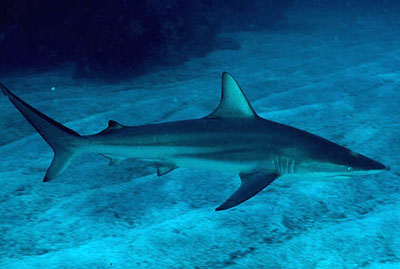
Distinctive Features
Blacktip sharks are stout-bodied with a moderately long and pointed snout. They lack an interdorsal ridge. The first dorsal fin, positioned slightly posterior to the pectoral fin insertion, is high with a narrowly pointed apex. The pectoral fins are fairly large and pointed (Compagno and Fowler 2005).
Coloration
The blacktip shark is dark gray to brown above, and white below with a distinct white band across the flank. The black tips found on the pectoral fins, first and second dorsals, pelvic fins, and lower caudal lobe are conspicuous, though they tend to fade with age. The blacktip does not usually have black tips on the anal fin (Compagno et al. 2005). The similar-looking spinner shark (Carcharhinus brevipinna) usually develop a black tip on its anal fin several months after birth.
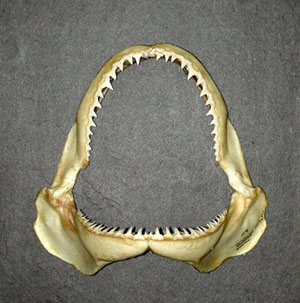
Dentition
The upper and lower jaw teeth of blacktip sharks are quite similar in shape, being moderately long, erect, and narrowly pointed with a broad base. The upper jaw teeth are more coarsely serrated along the cusp and crown than are the lower teeth which have fine serrations and tend to curve inwards. The teeth count is 15:2:15 in the upper jaw and 15:1:15 in the lower jaw.
Size, Age, and Growth
The maximum length of the blacktip shark is about 8 feet (255 cm). Size at birth is 20-26 inches (53-65 cm). Average adult size is around 4.9 feet (150 cm), weighing about 40 lbs (18 kg). Age at maturity is 4-5 years for males, and 6-7 years for females. The maximum age found has been 10 years (Burgess and Branstetter 2009).
In waters off the southeastern U.S., the length at maturity is 4.8 feet (145 cm) total length (TL) for males corresponding to a weight of approximately 43 pounds (19.5 kg) and 5.2 feet (156 cm) TL for females corresponding to a weight of approximately 55 pounds (25 kg) (Castro 1996).
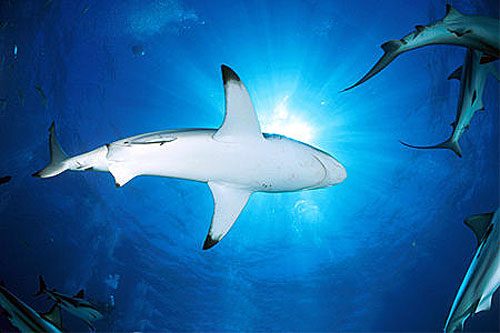
Food Habits
Blacktip sharks primarily feed on small schooling fishes such as herring, sardines, menhaden, mullet, and anchovies, but also eat other bony fishes including catfishes, groupers, jacks, snook, porgies, grunts, croakers, flatfishes, triggerfish, and porcupine fish. They are also known to consume other elasmobranchs including dogfish, sharpnose sharks, young dusky sharks, skates, and stingrays. Crustaceans and squids are also occasionally taken. Blacktips frequently follow fishing trawlers to eat the bycatch (Burgess and Branstetter 2009).
Blacktips, as well as spinner sharks, can often be seen breaching out of the water while feeding, sometimes spinning up three or four times around their axis before falling back in the water. This behavior is thought to facilitate the sharks’ predatory success while feeding on schools of fish near the surface.
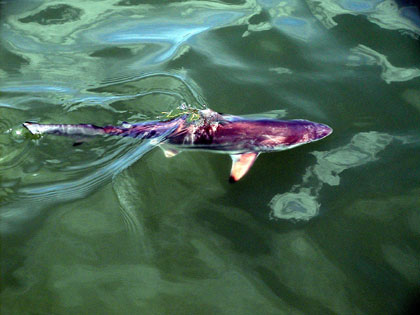
Reproduction
Blacktip sharks have placental viviparity. Embryos are nourished by a placental connection to the mother via an umbilical cord, analagous to the system seen in placental mammals, but independently derived. Gestation last 11-12 months. Between 4-11 pups are born in late spring and early summer (Castro 1996). Males reach sexual maturity at 4.4 to 5.9 feet (135-180 cm) total length. Females at 3.9-6.3 feet (120-190 cm). Females give birth in inshore estuarine nursery grounds where the young remain for the first years of their lives.
Predators
Adult blacktip sharks have few predators, but larger sharks like Sphyrna mokarran prey on migratory groups (Doan and Kajiura, 2020). Like other carcharhinid sharks, the young are often at risk of predation by larger sharks.
Parasites
External parasites found on the body of the blacktip shark include the copepods Pandarus sinuatus and Pandarus smithii.
Taxonomy
The blacktip shark was first described by Valenciennes in Muller & Henle (1839) as Carcharias (Prionodon) limbatus. It has also appeared in the literature as Carcharias (Prionodon) pleurotaenia, Carcharias microps, Carcharias (Prionodon) muelleri, Carcharias maculipinna, Carcharias ehrenbergi, Carcharias aethlorus, Gymnorrhinus abbreviatus, Carcharias phorcys, and Carcharhinus natator. The currently valid scientific name is Carcharhinus limbatus (Müller and Henle 1839). The genus name Carcharhinus is derived from the Greek “karcharos” = sharpen and “rhinos” = nose. The species name “limbatus” originates from Latin, meaning bordered in reference to the black markings on its fins.
References
Burgess, H. G. & Branstetter, S. (2009). Carcharhinus limbatus. The IUCN Red List of Threatened Species 2009: e.T3851A10124862. http://dx.doi.org/10.2305/IUCN.UK.2009-2.RLTS.T3851A10124862.en.
Castro, J. (1996). Biology of the Blacktip Shark, Carcharhinus Limbatus, off the Southeastern United States. Bulletin of Marine Science: 59(3) pp. 508-522.
Compagno, L., Dando, M., & Fowler, S. (2005). A Field Guide to the Sharks of the World. London: Harper Collins Publishers Ltd.
Doan, M.D. and Kajiura, S.M., 2020. Adult blacktip sharks (Carcharhinus limbatus) use shallow water as a refuge from great hammerheads (Sphyrna mokarran). Journal of fish biology, 96(6), pp.1530-1533.
Morgan, A. and Burgess, G. H. (2007). At-Vessel Fishing Mortality for Six Species of Sharks Caught in the Northwest Atlantic and Gulf of Mexico. Gulf and Caribbean Research: 19(2)
Revised by Tyler Bowling, Lindsay French, Jennifer Dorrian and Gavin Naylor 2020
Original preparation by Tobey Curtis